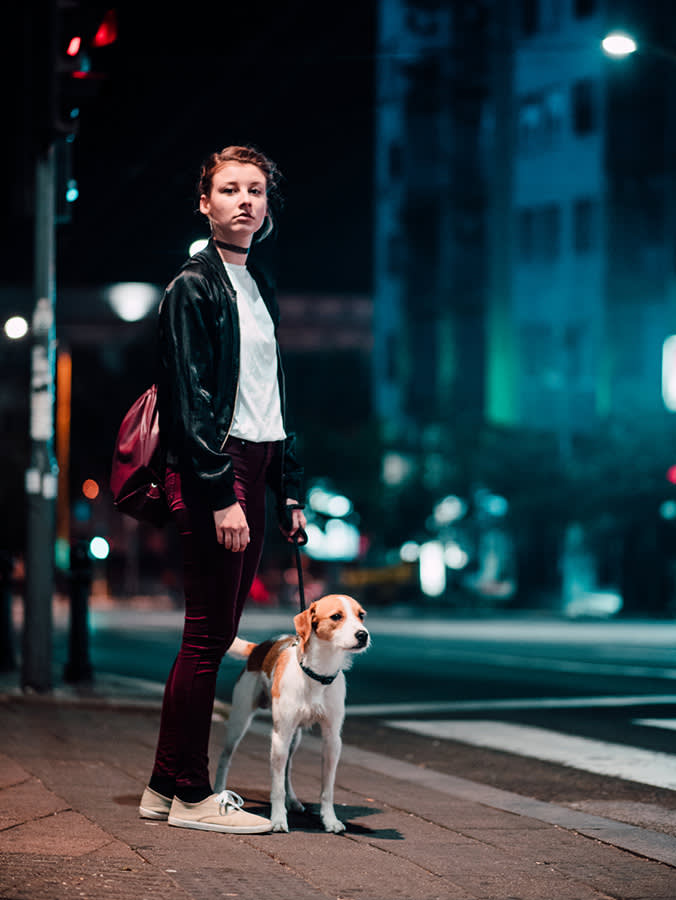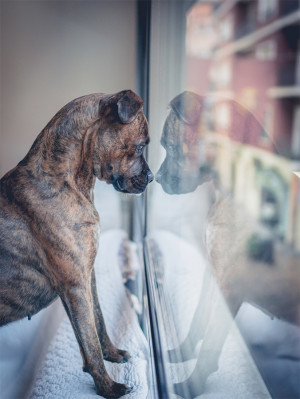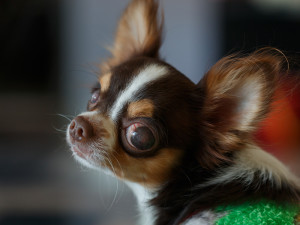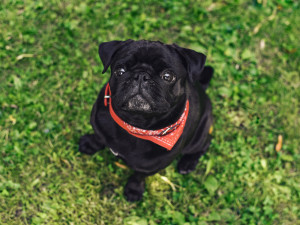Why Do Dogs’ Eyes Glow in the Dark?
The reason for your midnight jump-scare? Turns out it’s just your dog’s spooky eyes.

Share Article
Have you ever looked into a dark room, seen two glowing lights shining back at you and jumped about a foot before you realized it was just your sweet little pup and not a trash-hungry raccoon that had somehow made its way into your home?
Dog eyes glow in the dark because of a specialized structure called the tapetum lucidum. This layer of cells behind the retina reflects incoming light back through the retina, enhancing a dog’s night vision. The reflected light often appears green or yellowish to human observers. Not all dogs display the same level of eye glow, with existing variations among breeds and individuals. While this phenomenon is natural and not harmful, a sudden change in eye appearance should prompt a visit to the veterinarian.
What causes dog eyes to glow in the dark?
Dog eyes don’t actually “glow” or produce light in the dark — they reflect. Dogs have a special layer in the back of their eyes that acts as a mirror and reflects light back onto the retina, allowing more light to reach the receptors in the eye. To make this process more clear (pun intended), we’ll follow the path of light through a dog’s eye.
Light enters the eye through the cornea — the clear surface of the eye. Light then travels through the pupil, which is the opening in the middle of the eye. The iris (the colored portion of the eye) changes size to control the amount of light allowed to pass through the pupil. After passing through the pupil, light hits the lens, a clear disk that can change its shape to focus light onto the retina.

The retina is the light-sensitive layer at the back of the eye. Between the retina and the vessels that supply it with blood, there is a special reflect layer called the tapetum lucidum that reflects light back onto the retina, increasing the amount of light received for interpretation. This reflective layer causes dogs eyes to appear to glow in the dark. The information from the cells in the retina travels to the optic nerve, which connects the eye to the brain.
What is the purpose of this ability?
Dogs are not considered to be nocturnal animals like that raccoon you suspected was in your dark kitchen, but they are sometimes active at night. The ability to see well in low-light conditions, like at dawn or dusk, gives them a competitive advantage when it comes to hunting and avoiding predators.
Part of the reason a dog’s eye glows in the dark is so they are able to sense motion when there is less light available. This means they can sense moving objects (like prey) better than humans can. So if your dog suddenly focuses on what appears to be an invisible object at dawn or dusk, they may be looking at something that you can’t see.
Tapetum lucidum in dogs
The tapetum lucidum in dogs’ eyes is usually nine to 20 layers thick. It is an organized structure with cells that contain reflective crystals. In dogs, these cells are rich in zinc (a metal) and cysteine (an amino acid) that combine to function as a mirror. When light hits the tapetum lucidum, it is reflected back onto photoreceptor cells of the retina, allowing the light that didn’t reach a receptor the first time a second chance to be absorbed and processed by the brain.
This adaptation for low-light vision comes with a disadvantage. The reflection of light from the tapetum lucidum will scatter the light in a way that reduces a dog’s ability to see fine details. This is one of the reasons why dogs have worse visual acuity than humans. Visual acuity is a measurement of how well details of an object are seen at a given distance. When referring to people with 20/20 vision, this means they can see what the average person can see from 20 feet away. Using this standard, dogs are thought to have 20/75 vision, meaning they would need to be 20 feet away from an object to see the same amount of detail that the average person can see from 75 feet.
Do all breeds have tapetum lucidum?
Most dogs have a tapetum lucidum, though the appearance can vary in prominence and color. Siberian Huskies and other dogs with white fur and blue eyes are more likely to lack a tapetum lucidum. Toy breed dogs, such as the Pomeranian, have smaller tapetum lucidum than larger breed dogs.
Why do dogs’ eyes glow different colors?
The color of a dogs’ tapetum lucidum can vary. The amount of zinc cysteine in a dog’s tapetum lucidum can impact how reflective it is and the colors that it reflects. Yellow-green and orange are the most common colors for a dog’s tapetum lucidum. Blue-green, yellow, and green are commonly seen as well. One study documentedopens in new tab a correlation between coat color and tapetum lucidum color in dogs. Dogs with red or brown coats were more likely to have orange-ish tapetums, while dogs with white or gray coats were more likely to have greenish tapetums.
Color variation can also be affected by age. The tapetum lucidum cannot be seen in the first 35 days of a dog’s life. It gradually shifts in color and prominence during early puppyhood and becomes a stable color around three months of age. In a dog’s senior years, the tapetum lucidum can appear brighter as a result of retinal thinning or degeneration.
Some dogs have different-colored reflections in each eye. This is commonly seen with dogs with heterochromia — eyes with different colored irises. The tapetum lucidum in blue-eyed dogs tends to lack pigment, be underdeveloped, or be absent. A dog may have different-colored reflections or have one eye that lacks a reflection. This can be a normal feature if it has been present from puppyhood. If an adult dog has a sudden change in the reflectivity of just one eye, it may indicate an issue and should be checked by a veterinarian.
Why do my dog’s eyes glow red?
If a dog’s eyes reflect red, they likely lack a tapetum lucidum. The retina is rich with blood vessels. When light is reflected from an eye that lacks a tapetum lucidum (like a human’s), the red color of the retina is reflected back.
Why do my dog’s eyes glow green?
If it looks like a dog’s eyes are glowing green, you’re likely seeing the reflection from the tapetum lucidum. The spectrum of colors can vary from dog to dog, but a shade of green is commonly seen.
How else is night vision enhanced in dogs?
Dog vision is adapted to help them see better at night than humans can. The adaptations that help dogs see at night include:
Tapetum lucidum: The specialized layer of cells that reflects additional light onto the light receptors of the retina.
Large pupils: Dogs’ large pupils allow more light to reach the retina.
More rods than cones: The retina has two types of photoreceptors: rods that detect light and motion and cones that detect color. Dogs have more rods than humans do, making their vision more sensitive to light.
FAQs (People also ask):
Is eye-glow harmful to dogs?
Eye glow is not harmful to dogs. Eye glow is the result of reflection from the tapetum lucidum, a layer in the back of the eye that helps dogs see in low-light conditions.
Can the intensity of the eye-glow change in dogs?
The intensity of a dog’s eye glow increases in the first few months of puppyhood and decreases during a dog’s senior years.
Why does only one of my dog’s eyes glow?
A dog may have eye glow in only one eye if the other eye lacks a tapetum lucidum, which can be seen in blue eyes. If there is a sudden change in your dog’s eye glow, have them seen by a veterinarian.
References:

Dr. Alycia Washington, DVM, MS
Alycia Washington is a small-animal emergency veterinarian with over 10 years of experience based in North Carolina. She works as a relief veterinarianopens in new tab and provides services to numerous emergency and specialty hospitals. She also works as a veterinary writer with a focus on educating pet parents.
Related articles
![Small black pug in a red banana sitting in grass and looking up at camera, dogs eyes getting cloudy]()
Everything You Need to Know About Cataracts in Dogs
Here’s how to spot the eye condition and help your dog see more clearly.
![Cavalier King Charles Spaniel's eye is examined on the bed by a person]()
Dogs Get Dry Eye Too...Some Breeds More Than Others
Eyes without tears are only for Cameron Diaz in The Holiday.
Cherry Eye in Dogs: Why Is Your Dog’s Eye So Red?
That would be a cherry eye, and you’ll want to see your vet.
![French bulldog puppy looking scared at vet]()
10 Things to Ask at Your First Vet Visit
There are no stupid questions — well, when it comes to your dog’s health.
![Young woman looking at cellphone with her dog]()
Does Your Dog Understand When You FaceTime Them?
It’s a nice thought.








